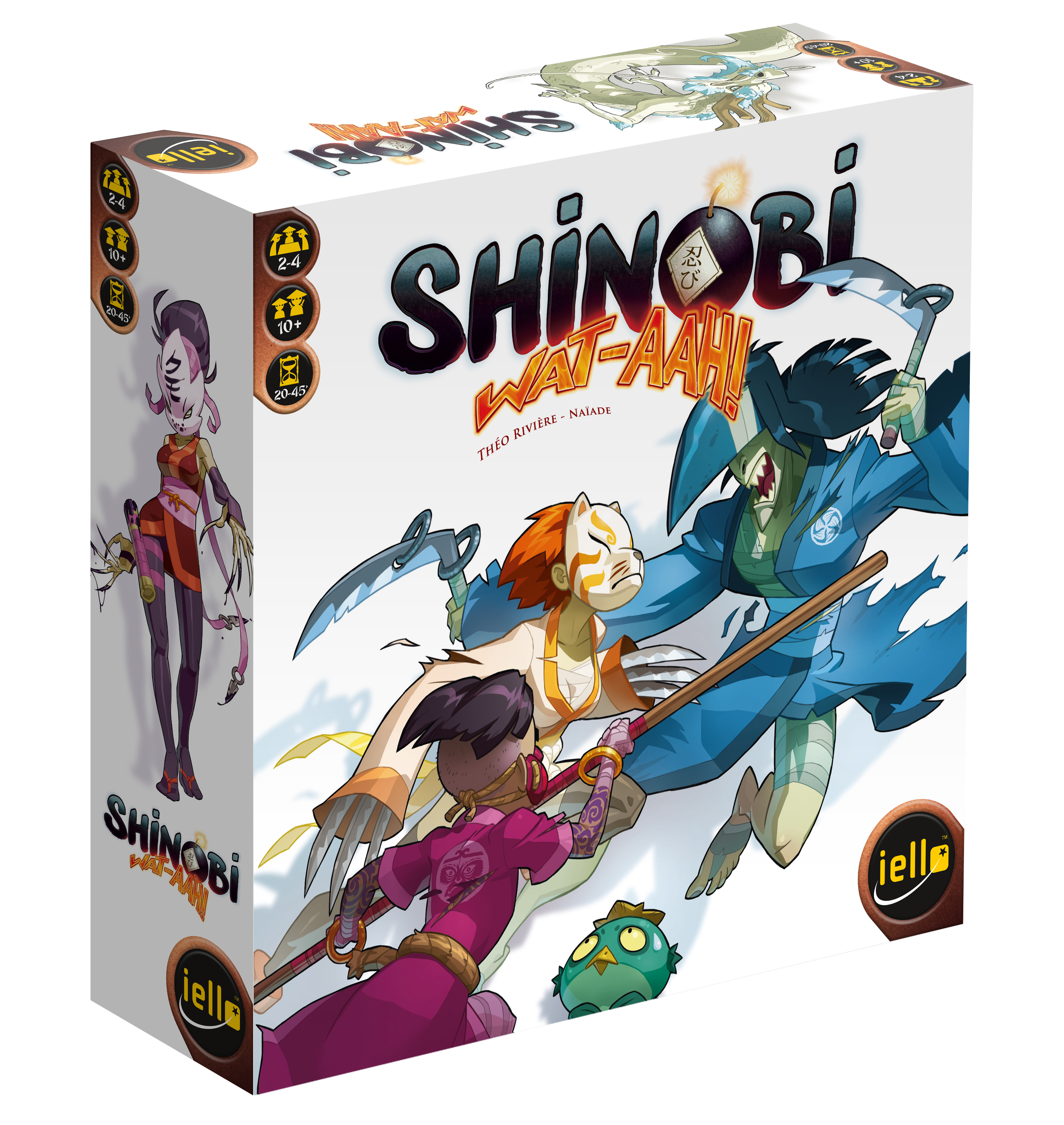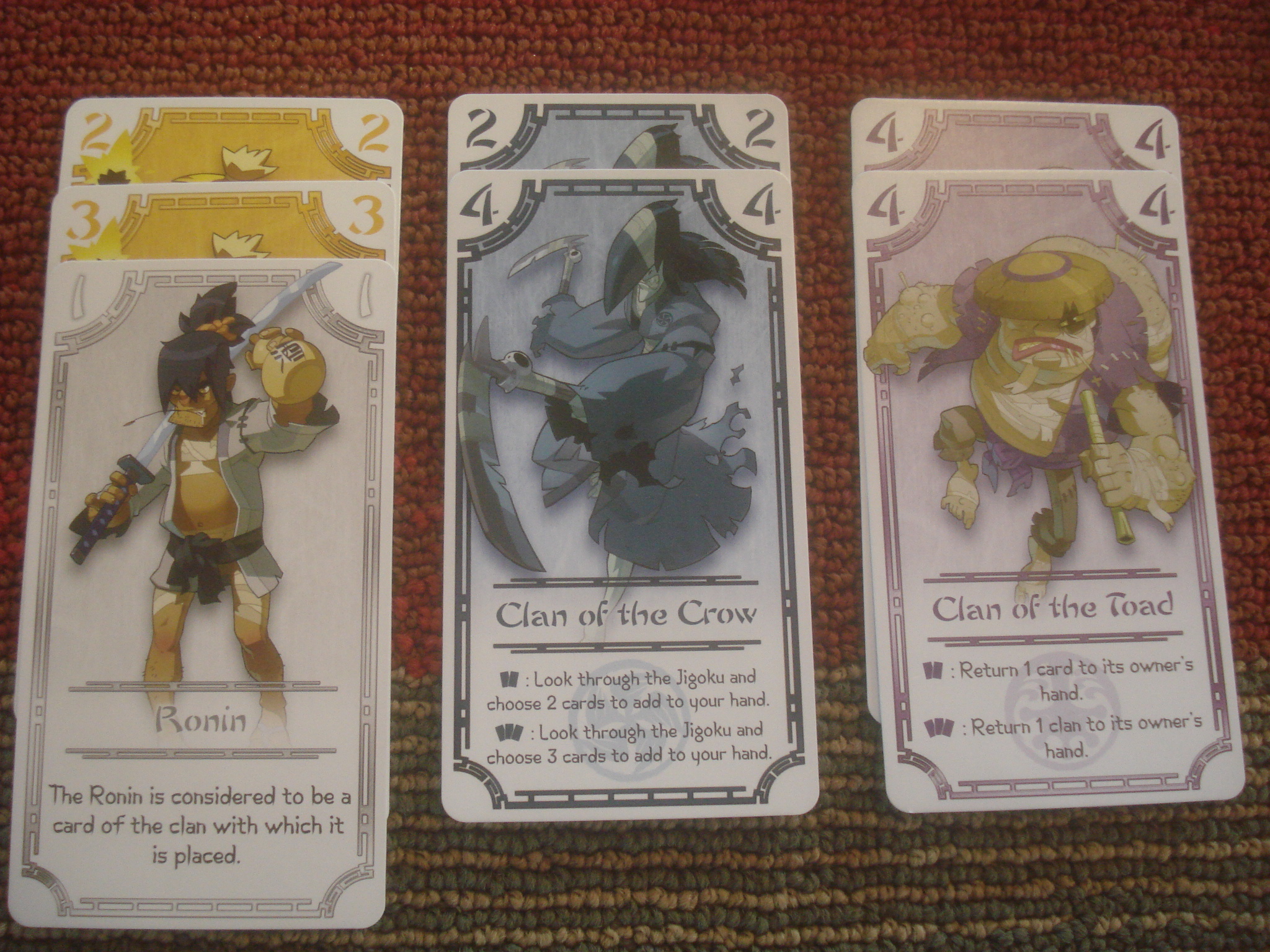| Publisher | Iello Games |
| Design Credit | Théo Rivière |
| Art & Graphics Credits | Naïade, Mikaël Brodu, Olivier Trocklé, Purple Brain Creations |
| Development Credit | Purple Brain Creations |
| Proofreading Credits | Peggy Cogny, Gabriel Durnerin, Ludovic Papaïs, Olivier Jahchan, Pierre Charriot, Max Charuel, Mikaël Brodu, the Bad Beer & Bad Geek team |
| Translation Credit | Nathan Morse |
| Game Contents | Board, four Ninja Master tokens and 48 Ninja pawns in four colors, 81 clan cards in nine colors, four ronin cards, nine yokai cards, 10 Temple of the Shadow cards, 10 Imperial Court cards, five Boss cards, Shosho of the Emperor (first player) token, rulebook |
| Guidelines | Game of battling monsters for the Japanese throne |
| MSRP | $39.99 |
| Reviewer | Andy Vetromile |
Japan, land of intrigue, where everyone wants to climb the social ladder and the top rung is usually becoming emperor. Chances are, from a historical viewpoint, there wasn’t actually a monster from another dimension squatting on the threshold of your victory, but in Shinobi Wat-aah! it’s best not to make assumptions. If you want the people on your side you must show them you can deal with trouble. Amass a ninja army and you can face both the creature and your destiny.
The object of the game is to have the most points at the end of three rounds.
Two to four rival warlords wish to seize the throne when its current, decrepit occupant finally gives up the ghost. The emperor’s death isn’t the only roadblock to commanding the kingdom: Otherworldly creatures penetrated this world and he/it/they must be dealt with before victory is assured. Everyone starts with a hand of cards, plus a Ninja Master token and set of throwing stars in their color. The octagonal board – nominally the realm for which you fight – has a monster of unknown power at its center. It is surrounded by Decoys, the draw deck, the discard pile, and two smaller decks of powerful cards not for the faint of heart.
Warlords call ninja clans to join them and give weight to their ambitions. On his turn a player draws, plays, and discards. He may nobly draw one Shinobi card or incur corruption by taking several. In the latter case he flips a Shinobi – its number not only helps determine how many cards he draws but the number of points that warlord is penalized for his dishonor at the end of the round. Two or more matching ninja are played together to start a clan – two Clan of the Dragon, for example – after which members are added in whatever denominations the player likes. Clan special abilities come in two- and three-card versions: For example, two Clan of the Crow cards let you claim two cards from Jigoku (the discard), but three members snag three discards. Clans max out at four members so one must balance points received with special abilities, i.e., use a two-card power twice or the more powerful three-card benefit once? Other effects include returning a clan to its owner’s hand or even destroying it outright, or borrowing the abilities of a rival.
When he’s done signing up ninja the player must discard a card and pass the turn to the next player. This continues until someone enlists their fourth clan and ends the round; then everyone sums their score. Card numbers are added up, corrupt card numbers are subtracted from one’s total, and the highest score wins the round. That warlord gets four shuriken from his supply while runners-up take three, two, and one from their own, and then those victory points are wiped clean. The throwing star tokens are used to score new, different points that win the game, and players distribute these Ninja pawns on the board. With five possible Final Bosses, ninja need throwing stars to peek at Decoys and narrow down the villain’s identity; gain Imperial Court cards with special powers; or attack the Boss monster himself. The lowest-scoring player also gets a Temple of the Shadow card or a free Decoy peek. Some beings like the Ankylosaurus-like Grugazor are straightforward – attack the creature with more stars, get more points – while others are trickier and penalize you for the wrong number of assaults like the wizened she(?)-imp Ma’ Maho.
When all shuriken are placed after three rounds the Boss monster is revealed and points for attacking him are added up. Players score for stars used to activate the sneak peek or Imperial Court spaces, and then the monster’s formula is added to or subtracted from that. Whoever has the highest score wins and now sits upon the throne.
There’s little to dislike about the Shinobi Wat-aah! components with a nice board, elongated cards that are a pleasure to shuffle, and clearly colored character tokens. No one’s going into combat with the wooden throwing stars (the rules specifically forbid it) but while they need to fit onto the board they’re tough to manage at that size (one or two were truncated in manufacturing and resemble butterflies). The rules say to stack them but then they’re harder to count at a glance. The rules also say things in French occasionally, and with seven people and two groups listed as proofreaders one must wonder what else slipped past. The cute, quirky card illustrations match the set’s tongue-in-cheek anime style (what else would you expect from a game that includes the Clan of the Carp?), though some aged warlords might need to break out the reading glasses for the tight formula graphics on the board spaces. A wicked cool plastic insert provides bins for pawns and tokens and the board caps them shut. Mostly. It’s octagonal so the corner-most depressions might allow escapees. And since they all fit in one small plastic baggie anyway . . .
Hard to know what’s deadlier in Japan, being emperor or becoming emperor, but as Shinobi Wat-aah! shows, the latter is certainly no picnic. The game’s Grasshopper mode forgoes the Boss monster phase to introduce the younger warlords to the joys of beating holy hell out of ninja; from there graduating to the full Grand Master version isn’t tough. It’s pretty fast until someone exceeds the recommended play time by freezing up on decision making (there’s one in every clan, isn’t there?). That at least hints at the multiple strategies, which is a good thing. Even straight-up attacking an opponent isn’t always the best move, for example – his point total goes down but now he can add people again and reuse the clan’s powers. Imperial Court and Temple of the Shadow cards throw more hand-trading, power-canceling, monster-peeking curves at players and the multiple yokai and ronin “wild cards,” loners who can bolster any dojo and bring still more abilities, fill out those “room for one more” card groups who just need a fourth member to qualify for that group discount at the Martial Arts Supply Shoppe.
A game with many paths to victory is something one does not tire of easily, and that’s what Shinobi Wat-aah!* is. With all the clan removals, reversals, and destructions, one might wonder if a round ever ends (or if powers do something more than take, swap, and destroy cards), but end it does and faster than you think. Some games layer on so many mechanics you wonder how many games you’re playing at once, but the dual point systems here – one to decide the round, one to win the game – is a simple means to a richer end. Players are challenged by the options, not buried in them, and left with just enough data to develop an informed but suspenseful, uncertain plan for dealing with the monsters. For its application of strategy and fun Shinobi Wat-aah! acquits itself with honor. Hai.
*The name, as fun to say as it is to play, comes from shinobi, “to steal away,” and wat-aah! or “boot to the head!” Loosely translated.




